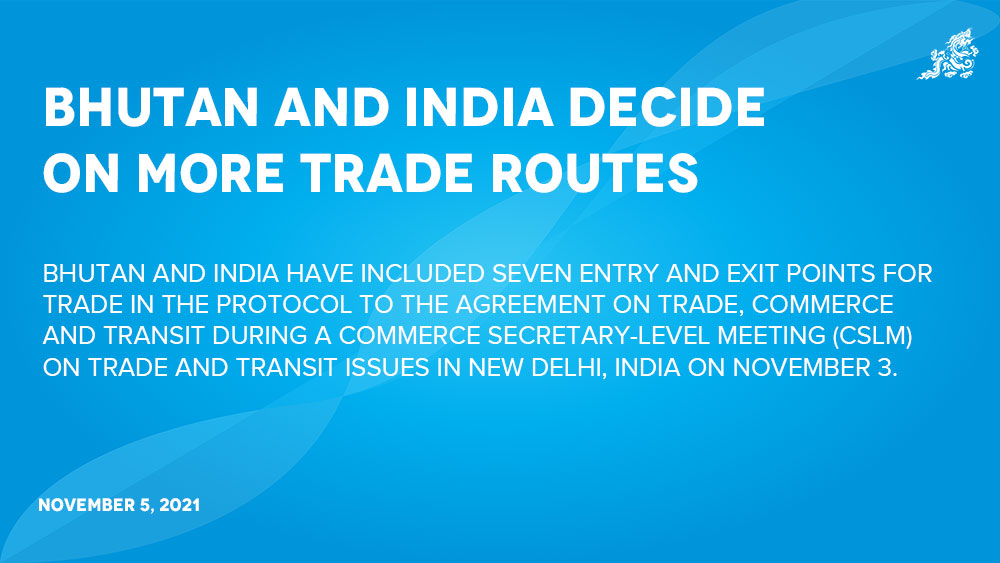Rajesh Rai | Phuentsholing
Bhutan and India have included seven entry and exit points for trade in the Protocol to the Agreement on Trade, Commerce and Transit during a commerce secretary-level meeting (CSLM) on trade and transit issues in New Delhi, India on November 3.
This is expected to increase trade connectivity between the two countries.
Economic affairs secretary, Karma Tshering headed the Bhutanese delegation. The Indian delegation was led by BVR Subrahmanyam, Secretary, Department of Commerce, Ministry of Commerce and Industry (MoCI).
According to an official statement from the MoCI, as per the Indian Embassy office in Thimphu, “The two sides held extensive discussions on the current trade and transit issues, including measures to further strengthen bilateral trade relations and issues of mutual interest, on ways to increase trade connectivity between the two countries.”
“This will form an addendum to the Protocol of 2016 India-Bhutan Agreement on Trade, Commerce and Transit. This will facilitate India-Bhutan bilateral trade to our mutual advantage,” the ministry stated.
Meanwhile, there are 21 approved exit and entry points in India for imports into and exports from Bhutan in the protocol to the Agreement on Trade, Commerce and Transit signed between Bhutan and India in 2016.
These seven additional entry and exit points were approved by the GoI in 2017 and 2020 but not included as part of the protocol to the bilateral agreement.
A delegation member said that following the CSLM 2021, a Letter of Exchange was signed to include these entry and exit points as part of the protocol to the bilateral trade agreement The seven entry-exit points include Nagarkata Land Customs Station (LCS), without commodity restriction, Agartala LCS, Pandu port (Guwahati Steamerghat), subject to cross border control at Dhubri, and Jogighopa port subject to cross border control at Dhubri.
Another entry-exit point is the Asian Highway 48 connecting Torsha Tea Garden in India and Ahllay in Pasakha as an additional route corresponding to the Jaigaon LCS.
Initially, GoI agreed to allow Ahllay LCS at Pasakha as a trading route for Pasakha industrial goods in July 2020. Later in October 2020, GoI approved trading of all goods and commodities.
Kamardwisa (Rangapani) and Birpara LCS are the other two entry-exit points.
Kamardwisa is in Assam, India and was notified in 2017. Exports through this route are mostly oranges, boulders, plaster of Paris, cement, cement clinkers and betel nut, among others. Imports through this place are mostly vegetables, construction materials, raw materials for local industries, among others.
Karmadwisa is about 140km away from Samdrupjongkhar and about 40 to 50km away from Nganglam.
Birpara is in West Bengal, India was also notified in 2017. Exports from here are mostly cement, pebbles, dolomite, boulder, cardamom, scrap and betel nut among others. Imports through Birpara are mostly raw materials for local industries and vegetables among others.
Meanwhile, it was in December 2020 that India agreed to open four trade routes of Nagarkata LCS, Agartala LCS, Pandu Port, and Jogighopa Port. Two riverine ports, Jogighopa and Pandu are both located in Assam on India’s National Waterway 2 along the Brahmaputra River.
A businessman in Gelephu said that Jogighopa would be the nearest riverine port with a distance of 98km from Gelephu. The riverine route will be three times cheaper than land transportation.
“Jogighopa is far more feasible,” he said. “It can accommodate three vessels compared to one by Dhubri riverine port.”
However, the logistics (port) development is yet to be completed, the businessman said. Pandu port, on the other hand, is fully developed. It is closer to Samdrupjongkhar; about 95km.
Agartala LCS is the farthest, about 750km away from Gelephu.
The delegation official said Pandu, Jogighopa and Agartala were approved by the GoI in 2020 but not notified.
“Now that the Letter of Exchange has been signed and these three entry and exit points have been included into the Protocol to the bilateral trade agreement, it will be notified for use by the GoI.”
“Jogighopa is being developed by the GoI as a multimodal logistics park which will only benefit Bhutan as it will also allow exports through the riverine system to both India and Bangladesh,” the official said.
The delegation official said there have been delays in the development of infrastructure at Jogighopa and the GoI has assured that priority will be given to developing the infrastructure at Jogighopa.
“There are already facilities at Agartala LCS and Pandu. Exports through these places would largely be boulders and aggregates, agricultural products, finished and semi-finished industrial goods,” the official said.
Nagarkata LCS was also approved for trade in 2020. However, trading was not carried from this route.
“If Nagarkata opens, we will use the Jitti border. It will be very beneficial. Distance to Bangladesh will shorten,” an exporter from Tashichholing said, adding that a distance of 80km will be shortened.
“Today we have to import from Silliguri for which we have to travel to Samtse,” he said.
The exporter said prior to the pandemic, Tashichholing traders imported and exported from Nagarkata.
The delegation member said that Nagarkata LCS in West Bengal, India corresponding to Jitti, Samtse (Bhutan) was notified as a permanent LCS without commodity restrictions in December 2020.
“Nagarkata remained non-operational as there was no required infrastructure and manpower in place. The road connecting Nagarkata bazaar to Jitti in Bhutan is being developed and other required infrastructure are being planned.”
As an interim measure to facilitate Bhutanese exports through this route, the delegation member said the GoI has committed to establishing a temporary infrastructure on a priority basis with the necessary manpower and other requirements such as the Indian Customs Electronic System to make the LCS operational.
Trade between India and Bhutan has more than doubled from USD 484 million (M) in 2014 to 2015 to USD 1.08 billion in 2020 to 2021.
Edited by Tshering Palden


